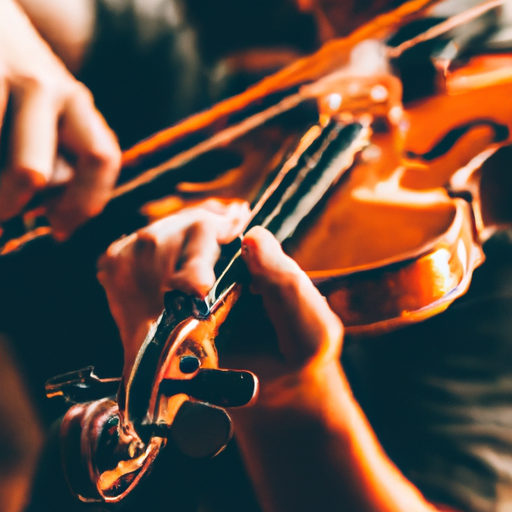
Learning to play a musical instrument is a rewarding and enriching experience. The violin, in particular, is a beautiful and versatile instrument that has captured the hearts of music lovers for centuries. Whether you are a complete beginner or have some musical background, the violin is a great choice for anyone looking to explore the world of music. In this article, we will provide you with easy violin tips for beginners to help you get started on your musical journey.

When starting your violin journey, it is crucial to find the right instrument that suits your needs. There are two options to consider: purchasing or renting a beginner violin. If you are unsure about committing to the instrument yet, renting can be a good option as it allows you to explore without a significant investment. However, if you are serious about learning and plan to continue playing, investing in your own violin is recommended. Look for a violin that is in good condition, has a solid build, and is within your budget.

Renting a beginner violin can be a cost-effective way to test the waters and see if playing the violin is something you enjoy before making a bigger commitment.
Before you start playing, it is essential to familiarize yourself with the different parts of the violin. This knowledge will help you develop a better understanding of how the instrument works and how to handle it properly. The main parts of the violin include the body, neck, fingerboard, bridge, soundpost, and tailpiece. Take your time to learn about their functions and how they contribute to the overall sound production.
Proper violin posture and positioning are crucial for producing a good sound and avoiding unnecessary strain on your body. Hold the violin under your chin, resting it on your collarbone and shoulder. Your left hand should support the neck of the violin, while your right hand holds the bow. Remember to keep your wrists relaxed and avoid tensing up. Developing a comfortable and natural playing position is essential for long-term progress.
Reading sheet music is a fundamental skill for any musician. The ability to understand musical notation will open up a world of possibilities for you as a violinist. Start by familiarizing yourself with the different symbols, notes, and rhythms commonly found in sheet music. Consider taking some online tutorials or enrolling in a beginner's music theory course to gain a solid foundation. Practice regularly to improve your sight-reading skills and become more confident in deciphering musical notation.
The bow is a crucial part of playing the violin. Learning proper bowing techniques is essential for creating a beautiful and expressive sound. Start by practicing long bow strokes on open strings to develop control and consistency. Experiment with the placement of the bow on the strings to achieve different tones and dynamics. As you progress, you can explore various bowing techniques such as staccato, spiccato, and legato to add variety to your playing.
Developing accurate finger placement is vital for playing the correct notes on the violin. Start by practicing basic scales and finger exercises to strengthen your fingers and improve muscle memory. Pay attention to the placement of your fingers on the fingerboard, ensuring that they are pressing down firmly on the strings without touching adjacent strings. Gradually increase the complexity of the exercises as you become more comfortable with the instrument.
Consistent and focused practice is key to becoming a skilled violinist. Set aside regular practice sessions and create a practice routine that works for you. Break down your practice into smaller, manageable segments and focus on specific techniques or pieces. Celebrate your progress and set achievable goals to stay motivated. Remember that practice is not just about repetition but also about active listening, analyzing, and refining your playing.
As a beginner, it is common to make mistakes while learning to play the violin. However, being aware of these mistakes can help you avoid developing bad habits and progress more effectively. Some common mistakes to watch out for include improper hand and finger placement, excessive tension in the bowing arm, and neglecting proper posture and positioning. Take your time to practice slowly and break down challenging passages to avoid rushing and sloppy playing.
While self-learning is possible with the wealth of online resources available, having a teacher or joining a violin class can greatly accelerate your learning process. A teacher can provide personalized guidance, correct mistakes, and offer valuable feedback to help you improve. They can also introduce you to a wider repertoire and help you develop a strong technical foundation. If joining a class, you can benefit from the motivation and camaraderie of fellow learners, making the journey more enjoyable.
If you are looking for more personalized instruction, consider finding a local teacher or seeking online violin lessons from reputable platforms. A teacher can guide you through the intricacies of playing the violin and help you overcome challenges.
Embarking on a journey to learn the violin is an exciting and fulfilling endeavor. While it may seem daunting at first, with consistent practice, dedication, and the right approach, you can make significant progress. Remember to be patient with yourself and enjoy the process of learning. Set achievable goals, celebrate small victories, and don't be afraid to ask for help when needed. The violin has a rich history and a beautiful sound that can captivate audiences and bring joy to your life. So pick up your violin, embrace the challenge, and enjoy the musical journey ahead!